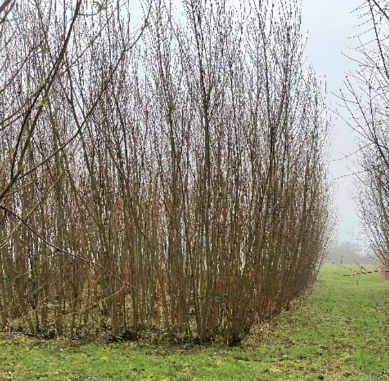Willow, when grown as a biomass crop, is often cultivated using the short rotation coppice (SRC) method. Here's an overview of how willow is grown using this approach:
1. Selection of Willow Varieties:
- The first step in growing willow as a biomass crop is selecting appropriate willow varieties. The choice of variety depends on factors like climate, soil type, and intended end-use (e.g., bioenergy, biofuels, or biomass for other purposes).
2. Planting:
- Willow is typically propagated from cuttings or young plants. The planting is usually done in rows or blocks, with sufficient spacing between plants to allow for optimal growth.
3. Coppicing:
- The SRC method involves regular coppicing, which is the practice of cutting the willow plants down to ground level after a specific growth period (typically every three to five years). This encourages the willow to send up new shoots or "stools."
4. Growth Cycle:
- Willow grows vigorously, and the SRC method takes advantage of this growth habit. After the initial planting, the first harvest occurs after the establishment phase (usually the second or third year), and subsequent harvests follow at regular intervals.
5. Sustainable Management:
- Proper management practices are essential for the health and longevity of the willow plantation. This includes maintenance activities such as pruning to remove dead or diseased wood, as well as weed control to minimize competition.
6. Soil and Nutrient Requirements:
- Willow is relatively adaptable to various soil types but thrives in moist, well-drained soils. Adequate soil nutrients are crucial for healthy growth. Soil testing and appropriate fertilization may be necessary.
7. Pest and Disease Management:
- Like any crop, willow is susceptible to pests and diseases. Integrated pest management and disease control strategies are employed to protect the crop.
8. Harvesting:
- Willow is typically harvested during the dormant season, usually in late winter or early spring, when the plant's energy is stored in the roots. Harvesting methods vary, but it typically involves cutting the stems at ground level. The harvested biomass can then be chipped, pelletized, or processed for its intended use.
9. Sustainability and Environmental Benefits:
- Willow's SRC method is known for its sustainability. The rapid growth and regular coppicing reduce the need for chemical inputs, help sequester carbon, and can improve soil quality. Willow's ability to thrive on marginal land also makes it an eco-friendly choice.
10. End Uses:
- The harvested willow biomass can be used for various purposes, including the generation of heat, electricity, biofuels, or as a feedstock for other bio-based products. Its versatility makes it a valuable resource for renewable energy and bioeconomy sectors.
Please share information, tools and resources relating to the cultivation of Willow as a biomass crop


